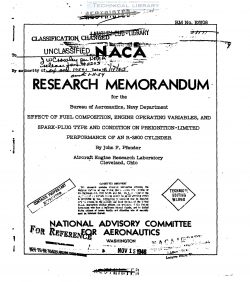naca-rm-e6j08
- Version
- 213 Downloads
- 1.07 MB File Size
- 1 File Count
- March 14, 2017 Create Date
- March 14, 2017 Last Updated
National Advisory Committee for Aeronautcs, Research Memorandum - Effect of Fuel Composition, Engine Operating Variables, and Spark Plug Type and Condition on Preignition-Limited Performance of an R-2800 Cylinder

The preignition problem in aircraft engines has become more
important as specific power output has increased. As knock limits
. have been raised through development _of better fuels, in some cases,
cylinder cooling has become marginal. The heat loading of cylinders
is therefore rapidly reaching the- limit where preignition rather
than knock becomes the limiting factor.
Studies have been made using a CFR engine (references 1
and 2), a 17.6 engine (reference 5), and an 0-1250 cylinder (ref-
erence 2) , which have shown. the preignition characteristics of various
fuels in these engines when using an engine-heated hot spot. The
effect of engine operating variables on the preignition—limited
performance of a GER engine and a 17.6 engine (ref-
erence 5) using an engine-heated hot spot have been recorded.
Extensive work has also been done to establish a standard procedure
for the determination of preignition ratings of aircraft spark plugs
in the 3.7.6 engine (reference 6) and preignition ratings based on
this method have been reported for many aircraft spark plugs.
The limitations of engine performance imposed by preignition
resulting from an engine-heated hot spot, however, vary with the
cylinder'type for a given set of operating conditions because of
differences in heat-transfer characteristics. The preignition rating
of one cylinder type on an absolute basis with respect to fuels,
spark plugs, and engine operating variables, therefore, cannot be
applied to another cylinder type; each type must be individually
rated. At the request of the Bureau of Aeronautics, Navy Department,
the perfomnce limitations of the 3-2800 engine that are imposed
by preignition and possible methods of eliminating its destructive
effects were investigated. at the MBA Cleveland laboratory. The pre-
ignition characteristics of this sin-cooled cylinder as affected by
changes in fuel, engine operating variables, spark-plug-type and
condition were evaluated. The effect on praignition-limited perform-
ance of various percentages of aromatics (benzene, tohzene, cumene,
and xylene) in. a base fuel of triptene was investigated. Two
paraffine (triptane and 8 plus 6.0 m1 TEL/gal) and two refinery blends
(28-3 and 35-3) were preignition-rated. The effect of changes in. the
following engine. operating variables on preigiition limit was deter-
mined: inlet-air temperature , reer-spark-plug-gasket temperature,
engine speed, spark advance, tappet clearance, and oil consImrption.
Preignition limits of the 3-2800 cylinder using Champion 0348 and
0558 and 911-1886, 1887, and 1.888 spark plugs were established and
the effect 'of spark-plug deterioration was investigated.
| File | Action |
|---|---|
| naca-rm-e6j08 Effect of Fuel Composition, Engine Operating Variables, and Spark Plug Type and Condition on.pdf | Download |

Comment On This Post